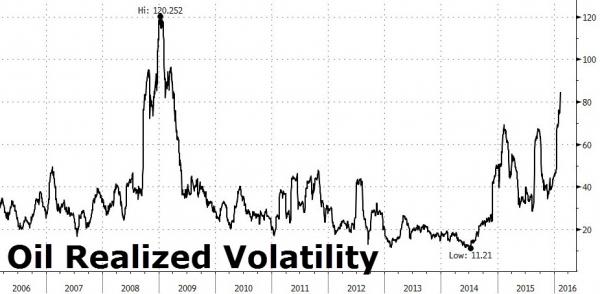Oil prices (and the broader financial markets) have suffered from acute bouts of volatility so far in 2016, with dramatic intraday swings the most worrying feature, and as OilPrice.com’s Charles Kennedy warns, this shows no signs of letting up.
With realized volatility soaring…

The CBOE Crude Oil Volatility Index, that tracks (as it name suggests) the implied volatility of crude oil, has spiked to a level not seen since the global financial meltdown in March 2009. While energy analysts have closely watched the crash of oil prices since mid-2014, only in the past two months – largely since OPEC’s December meeting – has crude oil volatility surged to its highest level in seven years.

Oil prices are at their lowest levels in more than a decade, but the daily up and down moves are leaving investors with whip lash. After crashing last week following bearish comments from the Federal Reserve, oil prices surged by more than 12 percent on Friday, the largest percentage gain in seven years, on more credible news that OPEC might be coming around to the idea of coordinated production cuts. What’s more, even after the 12.3 percent gain, crude oil still ended the week lower than it was on Monday.
What explains the volatility? Part of it is due to computerized trading that leads to feedback loops of buying and selling as large volumes of capital get moved around. But computerized trading is not a new phenomenon.
What is new is the instability in the financial markets. After nearly a decade of near zero interest rates from the U.S. Fed, the global economy still looks rather unsteady. There is no shortage of factors influencing oil prices today. Just to name a few: China’s growth is slowing; emerging market currencies have crashed; oil supply continues to exceed demand; oil in storage is at record levels; and Fed rate hikes may or may not be forthcoming.











Leave A Comment